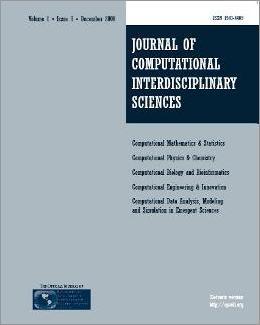
Editorial Office:
Management:
R. S. Oyarzabal
Technical Support:
D. H. Diaz
M. A. Gomez
W. Abrahão
G. Oliveira
Publisher by Knobook Pub


Editorial Office:
Management:
R. S. Oyarzabal
Technical Support:
D. H. Diaz
M. A. Gomez
W. Abrahão
G. Oliveira
Publisher by Knobook Pub
doi: 10.6062/jcis.2009.01.02.0021(Free PDF)
Thalita B. Veronese, Reinaldo R. Rosa, Nandamudi L. Vijaykumar and Mauricio J. A. Bolzan
Analysis of information from multiple data sources obtained through high resolution instrumental measurements has become a fundamental task in all scientific areas. The development of expert methods able to treat such multi-source data systems, with both large variability and measurement extension, is a key for studying complex scientific phenomena, especially those related to systemic analysis in space and environmental sciences. In this paper, we propose a time series generalization introducing the concept of generalized numerical lattice, which represents a discrete sequence of temporal measures for a given variable. In this novel representation approach each generalized numerical lattice brings post-analytical data information. We define a generalized numerical lattice £ as a set of three coefficients(?, ?` , µp), representing the following data properties: dimensionality, size and post-analytical parameters, respectively. From this generalization, any multi-source database can be reduced to a closed set of classified time series in spatio-temporal generalized dimensions. As a case study, we show a preliminary application in space science data, highlighting the possibility of a real time analysis expert system to be developed in a future work.
Multivariate time series, complex data systems, data representation, data integration, data modeling, data mining, systemic analysis.
[1] CLADIS PE & PALFFY-MUHORAY P. 1995. Spatio-Temporal Patterns in Nonequilibrium Systems. Addison-Wesley.
[2] YANNER-BAR-YAN. 1997. Dynamics of Complex Systems. Westview Press.
[3] SPIDR Space Physics Interactive Data Resource. http://spidr.ngdc.noaa.gov/spidr/home.do.
[4] BUCHNER J, DUM C & SCHOLER M (Eds.). 2003. Space Plasma Simulation. Lecture Notes in Physics, Springer.
[5] HANSLMEIER A. 2007. Sun and Space Weather. Astrophysics and Space Science Library Vol. 347, Springer.
[6] NASA National Aeronautics and Space Administration. http://www.nasa.gov.
[7] NOAA National Oceanic and Atmospheric Administration. http://www.noaa.gov.
[8] ESA European Space Agency. http://www.esa.int/esaCP/index.html.
[9] DUNN PF. 2005. Measurement and Data Analysis for Engineering and Science. McGraw-Hill.
[10] KESHNER MS. 1982. 1/f noise. Proceedings of the IEEE, 70(3): 212218. 10.1109/PROC.1982.12282
[11] BURNHAM KP & ANDERSON DR. 2002. Model Selection and Multimodel Inference: A Practical Information-Theoretic Approach, Springer.
[12] HEINZ-OTTO PEITGEN, JURGENS H & SAUPE D. 2004. Chaos and š Fractals: New Frontiers of Science. Springer.
[13] BOLZAN MJA, ROSA RR & SAHAI Y. 2009. Multifractal analysis of low-latitude geomagnetic fluctuations. Annales Geophysicae, 27: 569576.
[14] MECKE KR & STOYAN D. 2000. Statistical Physics and Spatial Statistics. Springer-Verlag.
[15] ROSA RR, SHARMA AS & VALDIVIA JA. 1999. Characterization of asymmetric fragmentation patterns in spatially extended systems. Int. J. Mod. Phys., C10: 147163.
[16] ROSA RR, CAMPOS MR, RAMOS FM, FUJIWARA S & SATO T. 2003. Gradient pattern analysis of structural dynamics: application to molecular system relaxation. Braz. J. Phys., 33: 605609.
[17] ROSA RR, BARONI MPMA, ZANIBONI GT, FERREIRA DA SILVA A, ROMAN LS, PONTES J & BOLZAN MJA. 2007. Structural Complexity of disordered surfaces: Analyzing the porous silicon SFM patterns. Physica A, 386(2): 666673.
[18] INPE National Institute for Space Research. http://www.inpe.br.
[19] ISTP-NASA. http://istp.gsfc.nasa.gov/istp/events/2000jun6/.
[20] Ondrejov Solar Radio Event Archive Info. http://www.asu.cas.cz/ radio/info.htm.
[21] HOLLIS M (Ed.). Simulation by Joachim Schmidt and Nat Gopalswamy, CISTO News, GSFC-NASA, http://cisto-news.gsfc.nasa.gov/08 -spring/helio -part1.html.